Impact of Open Innovation Communities on Enterprise Innovation Performance: A System Dynamics Perspective
Abstract
1. Introduction
2. Literature Review
2.1. Open Innovation Community (OIC)
2.2. Influencing Factors of Innovation Performance
2.3. System Dynamics
3. A Conceptual Model of Enterprise Innovation Performance
3.1. Knowledge Management Module
3.1.1. Knowledge Recognition
3.1.2. Knowledge Acquisition
3.1.3. Knowledge Transformation
3.1.4. Knowledge Application
3.2. Governance Mechanism Module
3.2.1. Organizational Mechanism
3.2.2. Technical Mechanisms
3.3. OIC User Behavior Module
3.3.1. User Innovation Behavior
3.3.2. User Interaction Behavior
4. Data Collection and Processing
4.1. The Xiaomi OIC
4.2. Data Collection
4.3. Data Cleaning and Descriptive Statistics
5. Establishment and Simulation of a System Dynamics Model
5.1. System Analysis
5.1.1. Modeling Purposes
5.1.2. System Boundary Determination
5.1.3. Basic Assumptions
5.2. Causal Relationship Analysis
5.2.1. Causal Relationship of Knowledge Management Subsystem
5.2.2. Causal Relationship of Governance Mechanism Subsystem
5.2.3. Causal Relationship of User Behavior Subsystem
5.2.4. Causality Diagram
5.3. System Dynamics Modeling
Variables and Calculations
5.4. Model Validation
5.4.1. A Runs Test
5.4.2. Historical Test
5.4.3. Sensitivity Test
5.5. Simulation Analysis
5.5.1. User Behavior Simulation Analysis Results
5.5.2. Governance Mechanism Simulation Analysis Results
5.5.3. Knowledge Management Simulation Analysis Results
5.6. Results and Discussions
6. Conclusions
6.1. Contributions
6.1.1. Theoretical Contributions
6.1.2. Practical Contributions
6.2. Limitations and Future Research
Author Contributions
Funding
Acknowledgments
Conflicts of Interest
References
- Fuller, J.; Hutter, K.; Hautz, J.; Matzler, K. User Roles and Contributions in Innovation-Contest Communities. J. Manag. Inf. Syst. 2014, 31, 273–308. [Google Scholar] [CrossRef]
- Schemmann, B.; Herrmann, A.M.; Chappin, M.M.H.; Heimeriks, G.J. Crowdsourcing ideas: Involving ordinary users in the ideation phase of new product development. Res. Policy 2016, 45, 1145–1154. [Google Scholar] [CrossRef]
- Liu, M.L.; Hull, C.E.; Hung, Y.T.C. Starting open source collaborative innovation: The antecedents of network formation in community source. Inf. Syst. J. 2017, 27, 643–670. [Google Scholar] [CrossRef]
- Huang, Y.; Singh, P.V.; Srinivasan, K. Crowdsourcing New Product Ideas Under Consumer Learning. Manag. Sci. 2014, 60, 2138–2159. [Google Scholar] [CrossRef]
- Martinez-Torres, M.R. Analysis of open innovation communities from the perspective of social network analysis. Technol. Anal. Strateg. Manag. 2014, 26, 435–451. [Google Scholar] [CrossRef]
- Mahr, D.; Lievens, A. Virtual Lead User Communities: Drivers of Knowledge Creation for Innovation. Res. Policy 2012, 41, 167–177. [Google Scholar] [CrossRef]
- Briel, F.V.; Recker, J. Lessons from a failed implementation of an online open innovation community in an innovative organization. Mis Q. Exec. 2017, 16, 35–46. [Google Scholar]
- Martinez-Torres, M.R. Application of evolutionary computation techniques for the identification of innovators in open innovation communities. Expert Syst. Appl. 2013, 40, 2503–2510. [Google Scholar] [CrossRef]
- Harland, P.E.; Nienaber, A.M. Solving the matchmaking dilemma between companies and external idea contributors. Technol. Anal. Strateg. Manag. 2014, 26, 639–653. [Google Scholar] [CrossRef]
- Martínez-Torres, M.R. Content analysis of open innovation communities using latent semantic indexing. Technol. Anal. Strateg. Manag. 2015, 27, 859–875. [Google Scholar] [CrossRef]
- Cui, T.R.; Ye, H.; Teo, H.H.; Li, J.Z. Information technology and open innovation. Inf. Manag. 2015, 52, 348–358. [Google Scholar] [CrossRef]
- Santoro, G.; Vrontis, D.; Thrassou, A.; Dezi, L. The Internet of Things: Building a knowledge management system for open innovation and knowledge management capacity. Technol. Forecast. Soc. Chang. 2018, 136, 347–354. [Google Scholar] [CrossRef]
- Zhou, R.; Qi, G.J. A System Dynamics Model for Open Innovation Community. Int. J. Enterp. Inf. Syst. 2018, 14, 78–88. [Google Scholar]
- Shin, K.; Kim, S.J.; Park, G. How does the partner type in R&D alliances impact technological innovation performance? A study on the Korean biotechnology industry. Asia Pac. J. Manag. 2016, 33, 141–164. [Google Scholar]
- Gold, A.H.; Malhotra, A.; Segars, A.H. Knowledge Management: An Organizational Capabilities Perspective. J. Manag. Inf. Syst. 2001, 18, 185–214. [Google Scholar] [CrossRef]
- Chen, L.; Fong, P.S.W. Evaluation of knowledge management performance: An organic approach. Inf. Manag. 2015, 52, 431–453. [Google Scholar] [CrossRef]
- Juison, B.; Wardani, S.P.R.; Wibowo, M.A. Innovation Performance of Large Contractor in Indonesia: Influencing Factors and its Impact on Firm’s Performance. Procedia Eng. 2017, 171, 370–378. [Google Scholar] [CrossRef]
- Palacios-Marques, D.; Roig-Dobon, S.; Comeig, I. Background factors to innovation performance: Results of an empirical study using fsQCA methodology. Qual. Quant. 2016, 51, 1939–1953. [Google Scholar] [CrossRef]
- Wang, D.; Nie, R.; Long, R.Y.; Shi, R.Y.; Zhao, Y.Y. Scenario prediction of China’s coal production capacity based on system dynamics model. Resour. Conserv. Recycl. 2018, 129, 432–442. [Google Scholar] [CrossRef]
- Kunc, M.; Mortenson MJVidgen, R. A computational literature review of the field of System Dynamics from 1974 to 2017. J. Simul. 2018, 12, 115–127. [Google Scholar] [CrossRef]
- Tomaskova, H.; Kuhnova, J.; Cimler, R.; Dolezal, O.; Kuca, K. Prediction of population with Alzheimer’s disease in the European Union using a system dynamics model. Neuropsychiatr. Dis. Treat. 2016, 12, 1589–1598. [Google Scholar] [PubMed]
- Xiao, B.; Chankong, V. A System Dynamics Model for Predicting Supply and Demand of Medical Education Talents in China. Eurasia J. Math. Sci. Technol. Educ. 2017, 13, 5033–5047. [Google Scholar] [CrossRef]
- Dasgupta, D.; Debsarkar, A.; Hazra, T.; Bala, B.K.; Gangopadhyay, A.; Chatterjee, D. Scenario of future e-waste generation and recycle-reuse-landfill-based disposal pattern in India: A system dynamics approach [J]. Environ. Dev. Sustain. 2016, 19, 1473–1487. [Google Scholar] [CrossRef]
- Pervin, L.; Islam, M.S. System dynamics approach for modeling of sugar beet yield considering the effects of climatic variables. J. Sci. Food Agric. 2015, 95, 515–521. [Google Scholar] [CrossRef] [PubMed]
- Hsieh, Y.H.; Chou, Y.H. Modeling the impact of service innovation for small and medium enterprises: A system dynamics approach. Simul. Model. Pract. Theory 2018, 82, 84–102. [Google Scholar] [CrossRef]
- Nazareth, D.L.; Choi, J. A system dynamics model for information security management. Inf. Manag. 2015, 52, 123–134. [Google Scholar] [CrossRef]
- Faham, E.; Rezvanfar, A.; Mohammadi, S.H.M.; Nohooji, M.R. Using system dynamics to develop education for sustainable development in higher education with the emphasis on the sustainability competencies of students. Technol. Forecast. Soc. Chang. 2016, 123, 307–326. [Google Scholar] [CrossRef]
- Jhawar, A.; Garg, S.K. System Dynamics Modelling to Study the Effects of Investment in Information Technology on Logistics Performance: A Case Study from India. IGI Glob. 2016, 5, 19–40. [Google Scholar] [CrossRef]
- Ercan, T.; Onat, N.C.; Tatari, O. Investigating carbon footprint reduction potential of public transportation in United States: A system dynamics approach. J. Clean. Prod. 2016, 133, 1260–1276. [Google Scholar] [CrossRef]
- Xu, S.H.; Jiang, J.Z. System dynamic simulation of knowledge management based on financial service innovation: A case study of Shanghai FTZ. In Proceedings of the 2017 International Conference on Management Science and Management Innovation, Suzhou, China, 23–25 June 2017; Volume 31, pp. 264–270. [Google Scholar]
- An, L.P.; Du, Y.M.; Tong, L.Y. Study on Return Policy in E-Commerce Environment Based on System Dynamics. In Proceedings of the 2016 Information Technology and Mechatronics Engineering Conference, Chongqing, China, 21–22 May 2016; Volume 24, pp. 428–431. [Google Scholar]
- Fang, Y.; Lim, K.H.; Qian, Y.; Feng, B. System Dynamics Modeling for Information Systems Research: Theory of Development and Practical Application. MIS Q. 2018, 42, 1303–1329. [Google Scholar]
- Wu, A.H.; Wang, Z.; Chen, S.D. Impact of specific investments, governance mechanisms and behaviors on the performance of cooperative innovation projects. Int. J. Proj. Manag. 2017, 35, 504–515. [Google Scholar] [CrossRef]
- Nawab, S.; Nazir, T.; Zahid, M.M.; Fawad, S.M. Knowledge Management, Innovation and Organizational Performance. Int. J. Knowl. Eng. 2015, 1, 43–48. [Google Scholar] [CrossRef]
- Ramirez, M.S.; Garcia-Penalvo, F.J. Co-creation and open innovation: Systematic literature review. Comunicar 2018, 54, 9–18. [Google Scholar] [CrossRef]
- Srivastava, M.K.; Gnyawali, D.R.; Hatfield, D.E. Behavioral implications of absorptive capacity: The role of technological effort and technological capability in leveraging alliance network technological resources. Technol. Forecast. Soc. Chang. 2015, 92, 346–358. [Google Scholar] [CrossRef]
- Bootz, J.P.; Durance, P.; Monti, R. Foresight and knowledge management. New developments in theory and practice. Technol. Forecast. Soc. Chang. 2019, 140, 80–83. [Google Scholar] [CrossRef]
- Guo, R.P.; Cai, L.; Fei, Y.P. Knowledge integration methods, product innovation and high-tech new venture performance in China. Technol. Anal. Strateg. Manag. 2019, 31, 306–318. [Google Scholar] [CrossRef]
- Frankort, H.T.W. When does knowledge acquisition in R&D alliances increase new product development? The moderating roles of technological relatedness and product-market competition [J]. Res. Policy 2016, 45, 291–302. [Google Scholar]
- Liang, H.S.; Wei, J.; Wan, X.M. The Change of Enterprise Technological Innovation Capability System and Its Performance Impact Mechanism—New Paradigm of Haier Open Innovation. Manag. Rev. 2018, 30, 281–291. [Google Scholar]
- Tippmann, E.; Scott, P.S.; Parker, A. Boundary Capabilities in MNCs: Knowledge Transformation for Creative Solution Development. J. Manag. Stud. 2017, 54, 455–482. [Google Scholar] [CrossRef]
- Taherparvar, N.; Esmaeilpour, R.; Dostar, M. Customer knowledge management, innovation capability and business performance: A case study of the banking industry. J. Knowl. Manag. 2014, 18, 591–610. [Google Scholar] [CrossRef]
- Havakhor, T.; Soror, A.A.; Sabherwal, R. Diffusion of knowledge in social media networks: Effects of reputation mechanisms and distribution of knowledge roles. Inf. Syst. J. 2018, 28, 104–141. [Google Scholar] [CrossRef]
- Cabrilo, S.; Dahms, S. How strategic knowledge management drives intellectual capital to superior innovation and market performance. J. Knowl. Manag. 2018, 22, 621–648. [Google Scholar] [CrossRef]
- Noh, M.; Kim, H.; Jang, H. Learning performance and business performance of knowledge management organizations: The moderating effect of technological capability. Inf. Dev. 2016, 32, 637–654. [Google Scholar] [CrossRef]
- Hedstrom, P.; Wennberg, K. Causal mechanisms in organization and innovation studies. Innov. Manag. Policy Pract. 2017, 19, 91–102. [Google Scholar] [CrossRef]
- Argote, L.; Hora, M. Organizational Learning and Management of Technology [J]. Prod. Oper. Manag. 2017, 26, 579–590. [Google Scholar] [CrossRef]
- Cetindamar, D.; Phaal, R.; Probert, D.R. Technology management as a profession and the challenges ahead. J. Eng. Technol. Manag. 2016, 41, 1–13. [Google Scholar] [CrossRef]
- Bustinza, O.F.; Gomes, E.; Vendrell-Herrero, F.; Baines, T. Product-service innovation and performance: The role of collaborative partnerships and R&D intensity. RD Manag. 2019, 49, 33–45. [Google Scholar]
- Manniche, J.; Testa, S. Towards a multi-levelled social process perspective on firm innovation: Integrating micro, meso and macro concepts of knowledge creation. Ind. Innov. 2019, 25, 365–388. [Google Scholar] [CrossRef]
- Li, M.G.; Kankanhalli, A.; Kim, S.H. Which ideas are more likely to be implemented in online user innovation communities? An empirical analysis. Decis. Support Syst. 2016, 84, 28–40. [Google Scholar] [CrossRef]
- Lin, H.W.; Chen, Y.P.; Yang, Y.S. Cluster Analysis of Automobile Innovative Users Based on Interactive Innovation Value. Math. Probl. Eng. 2018. [Google Scholar] [CrossRef]
- Qin, M.; Qiao, H.; Chen, L.H. Online User Contribution Behavior in Enterprise-hosted Open Innovation Communities Based on Complex Adaptive System: An Example of Chinese Famous Enterprise-hosted Community. Manag. Rev. 2015, 27, 126–137. [Google Scholar]
- Lu, P.; Yuan, S.M.; Wu, J.L. The interaction effect between intra-organizational and inter-organizational control on the project performance of new product development in open innovation. Int. J. Proj. Manag. 2017, 35, 1627–1638. [Google Scholar] [CrossRef]
- Graf, J.; Erba, J.; Harn, R.W. The Role of Civility and Anonymity on Perceptions of Online Comments. Mass Commun. Soc. 2017, 20, 526–549. [Google Scholar] [CrossRef]
- Kaiserfeld, T. Revolutionizing Innovation: Users, Communities, and Open Innovation. Technol. Cult. 2017, 58, 613–614. [Google Scholar] [CrossRef]
- Calof, J.; Meissner, D.; Razheva, A. Overcoming open innovation challenges: A contribution from foresight and foresight networks. Technol. Anal. Strateg. Manag. 2018, 30, 718–733. [Google Scholar] [CrossRef]
- Yang, H.J.; Yang, J.J. The effects of transformational leadership, competitive intensity and technological innovation on performance. Technol. Anal. Strateg. Manag. 2019, 31, 292–305. [Google Scholar] [CrossRef]
- Parmentier, G.; Mangematin, V. Orchestrating innovation with user communities in the creative industries. Technol. Forecast. Soc. Chang. 2014, 83, 40–53. [Google Scholar] [CrossRef]
- Yang, X.M.; Song, S.Q.; Zhao, X.S.; Yu, S.Q. Understanding user behavioral patterns in open knowledge communities. Interact. Learn. Environ. 2018, 26, 245–255. [Google Scholar] [CrossRef]
- Hossain, M.; Islam, K.M.Z. Generating Ideas on Online Platforms: A Case Study of “My Starbucks Idea”. Arab Econ. Bus. J. 2015, 10, 102–111. [Google Scholar] [CrossRef]
- Shin, K.; Kim, E.; Jeong, E. Structural Relationship and Influence between Open Innovation Capacities and Performances. Sustainability 2018, 10, 2787. [Google Scholar] [CrossRef]
- Li, Y.Y. Research on User Contribution and Innovation Management of Enterprise Open Innovation Community-Based on Starbucks Data Analysis [D]. Ph.D. Thesis, Shandong University, Shandong, China, 2017. [Google Scholar]
- Li, M.W.; Jia, S.L.; Du, W.Y. Fans as a source of extended innovation capabilities: A case study of Xiaomi Technology. Int. J. Inf. Manag. 2019, 44, 204–208. [Google Scholar] [CrossRef]
- Qin, M.; Liang, S. Study on User Recognition Mechanism and Contribution Behavior in Online Innovation Communities: Based on Prosocial Behavior Theory. Nankai Bus. Rev. 2017, 20, 28–39. [Google Scholar]
- Yilmaz, F. Social Presence and Transactional Distance as an Antecedent to Knowledge Sharing in Virtual Learning Communities. J. Educ. Comput. Res. 2017, 55, 844–864. [Google Scholar] [CrossRef]
- Durmus-Ozdemir, E.; Abdukhoshimov, K. Exploring the mediating role of innovation in the effect of the knowledge management process on performance. Technol. Anal. Strateg. Manag. 2018, 30, 596–608. [Google Scholar] [CrossRef]
- Magnier-Watanabe, R.; Benton, C. Management innovation and firm performance: The mediating effects of tacit and explicit knowledge. Knowl. Manag. Res. Pract. 2017, 15, 325–335. [Google Scholar] [CrossRef]

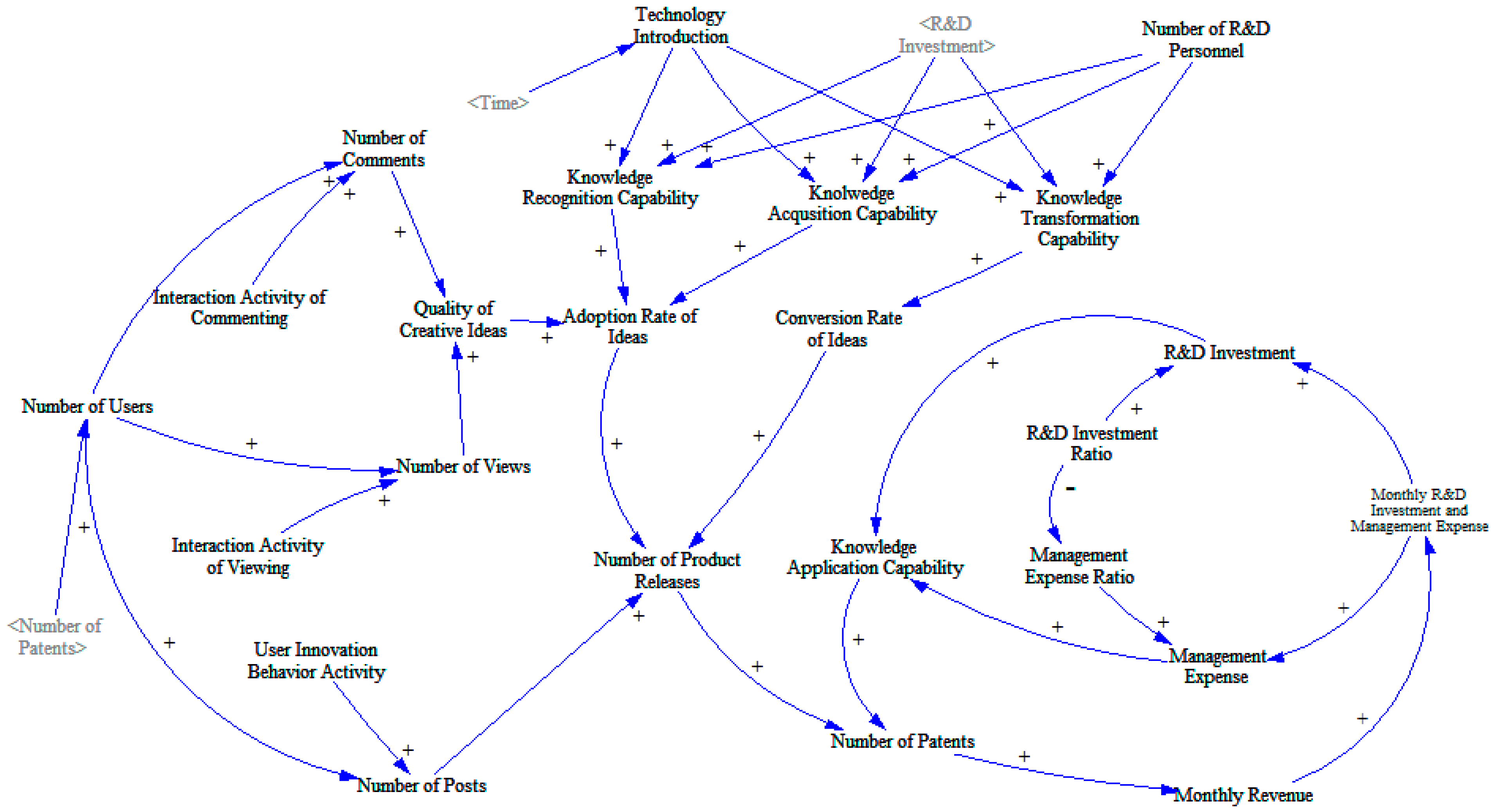
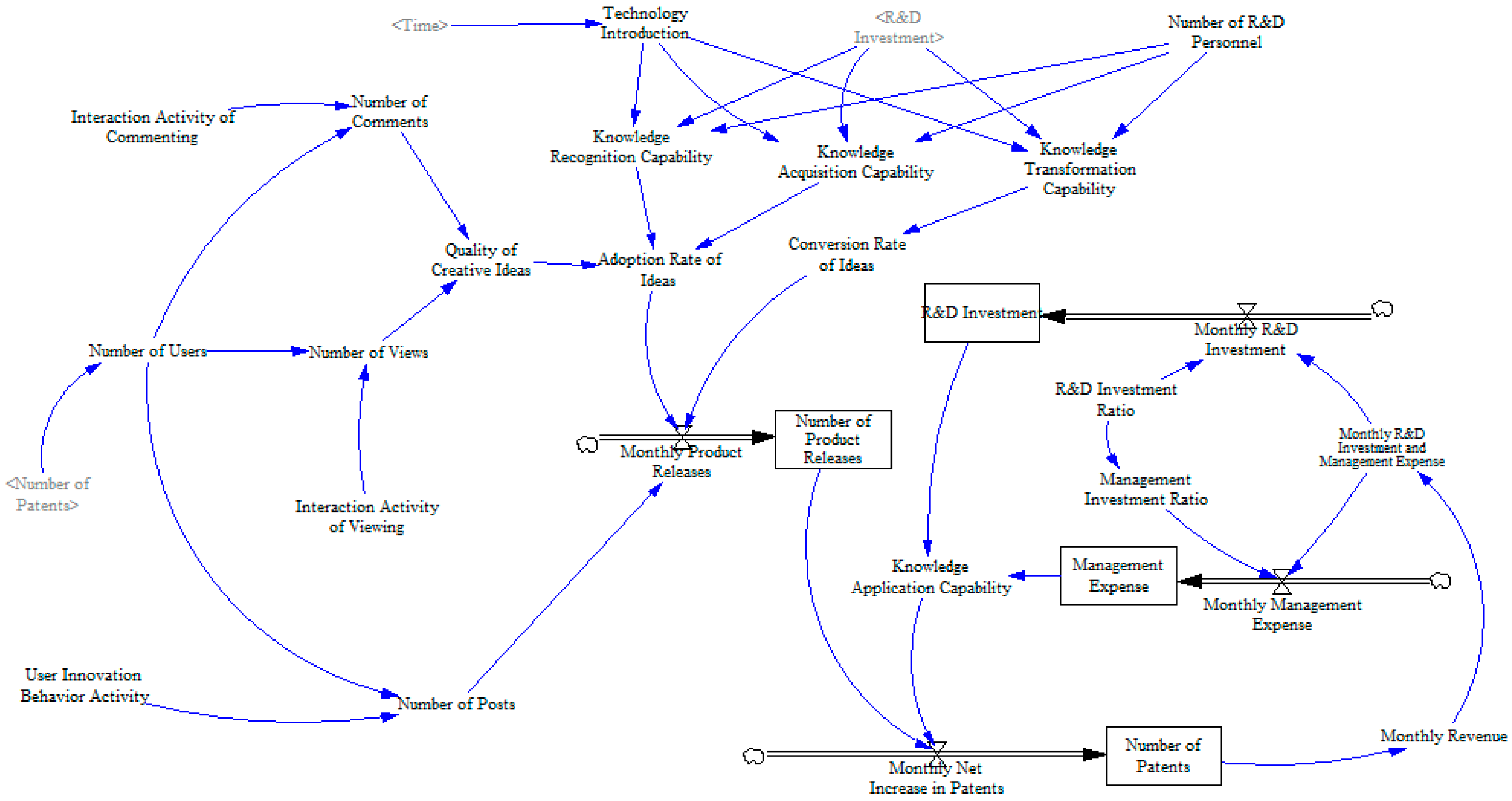
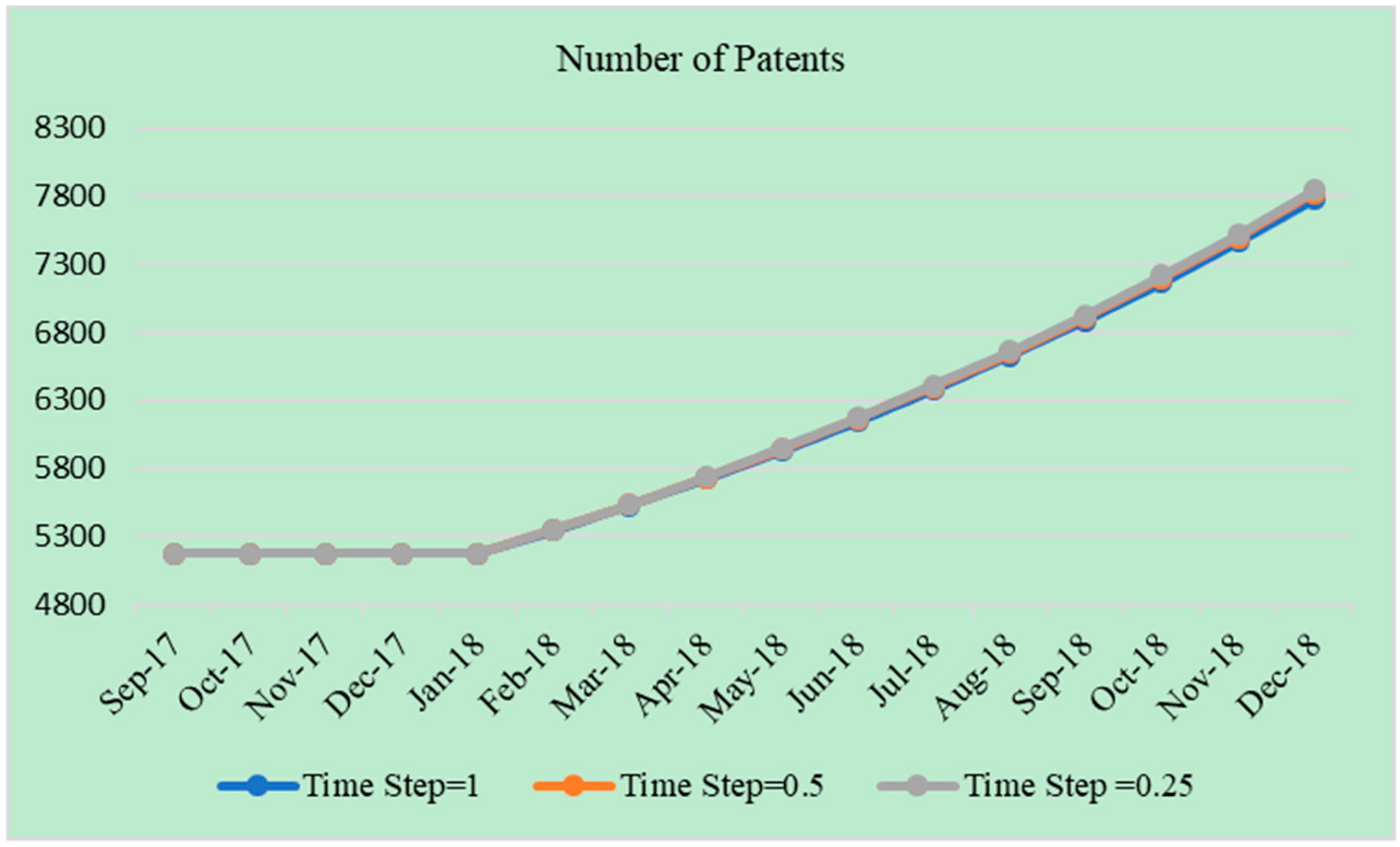

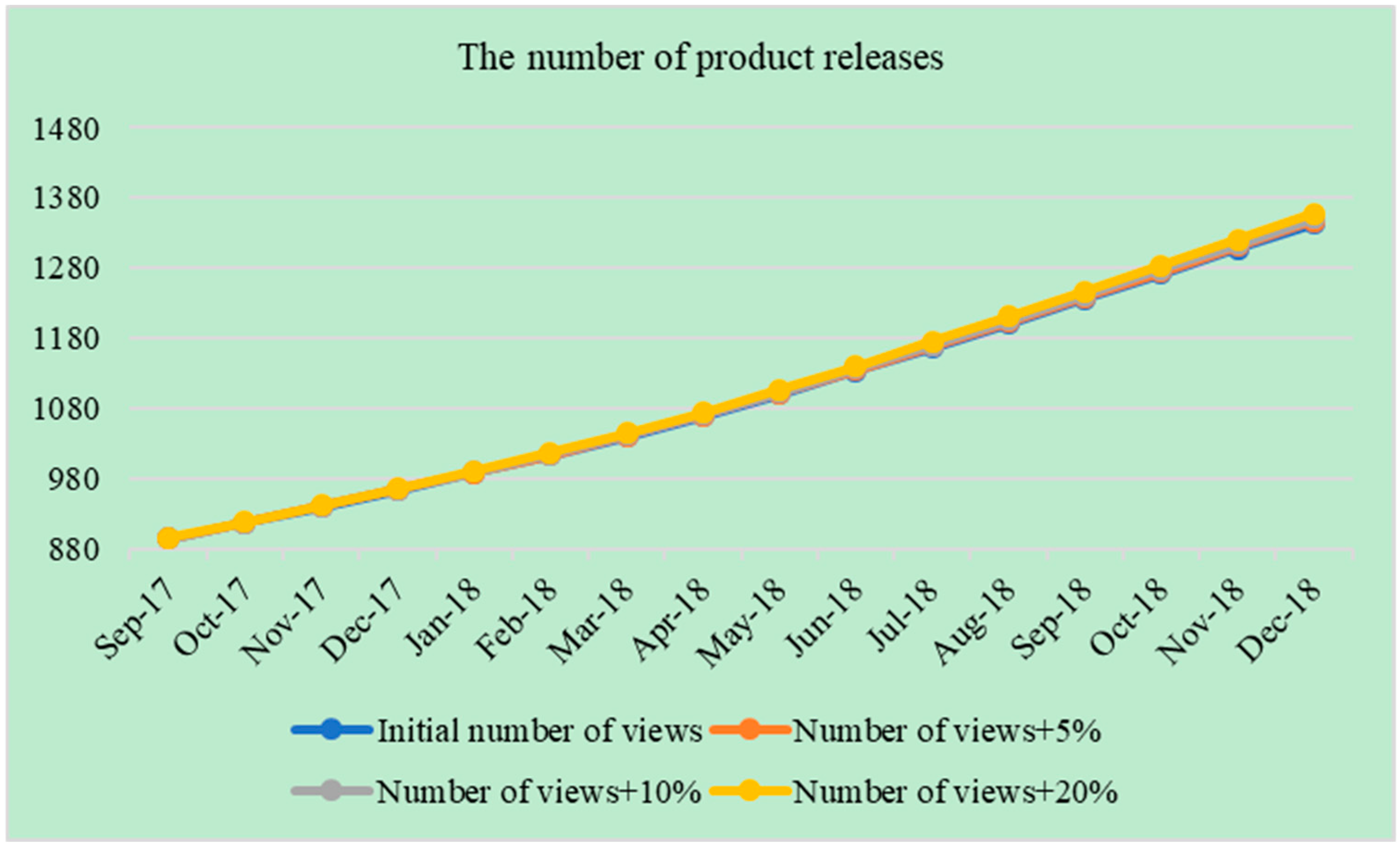

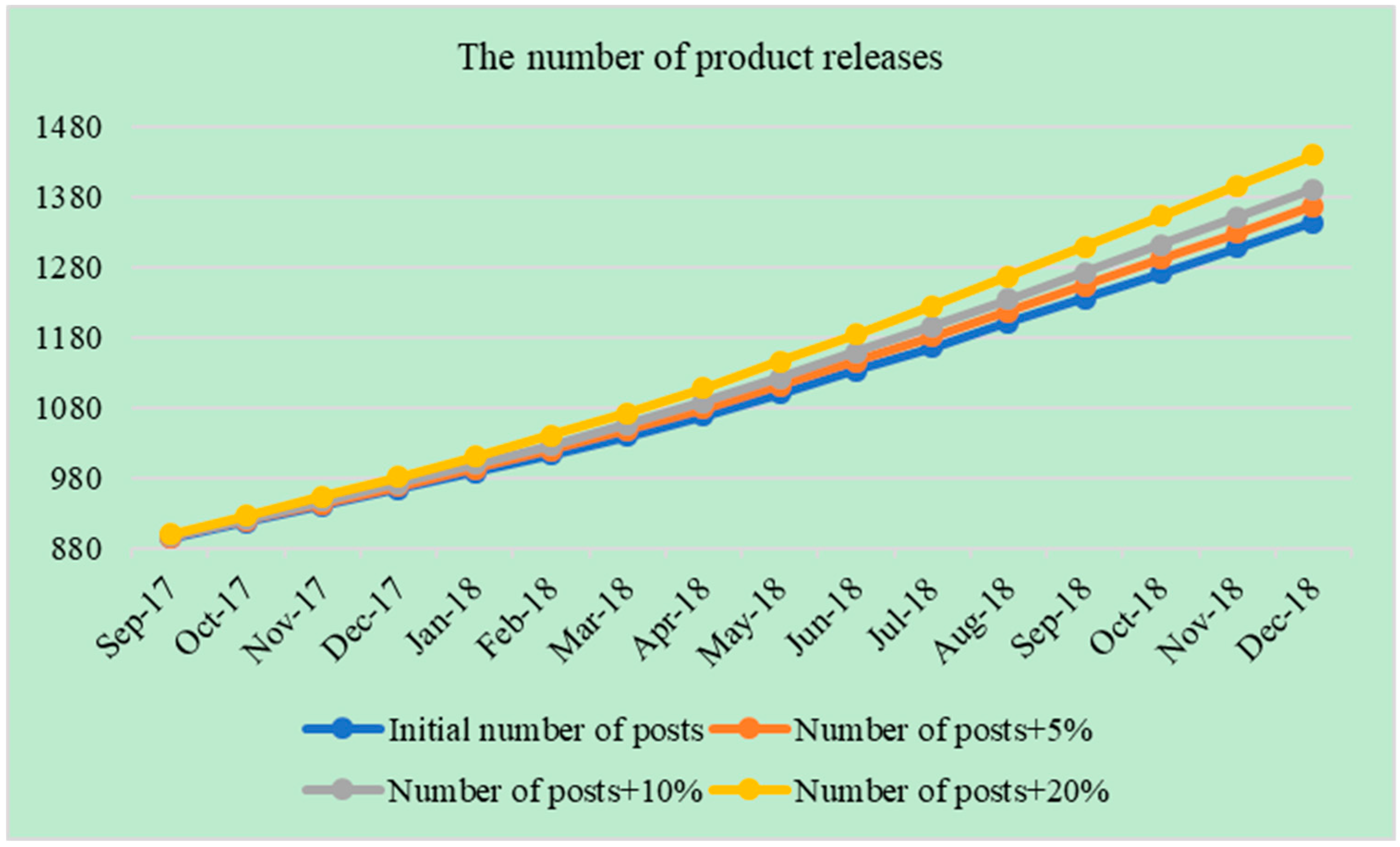


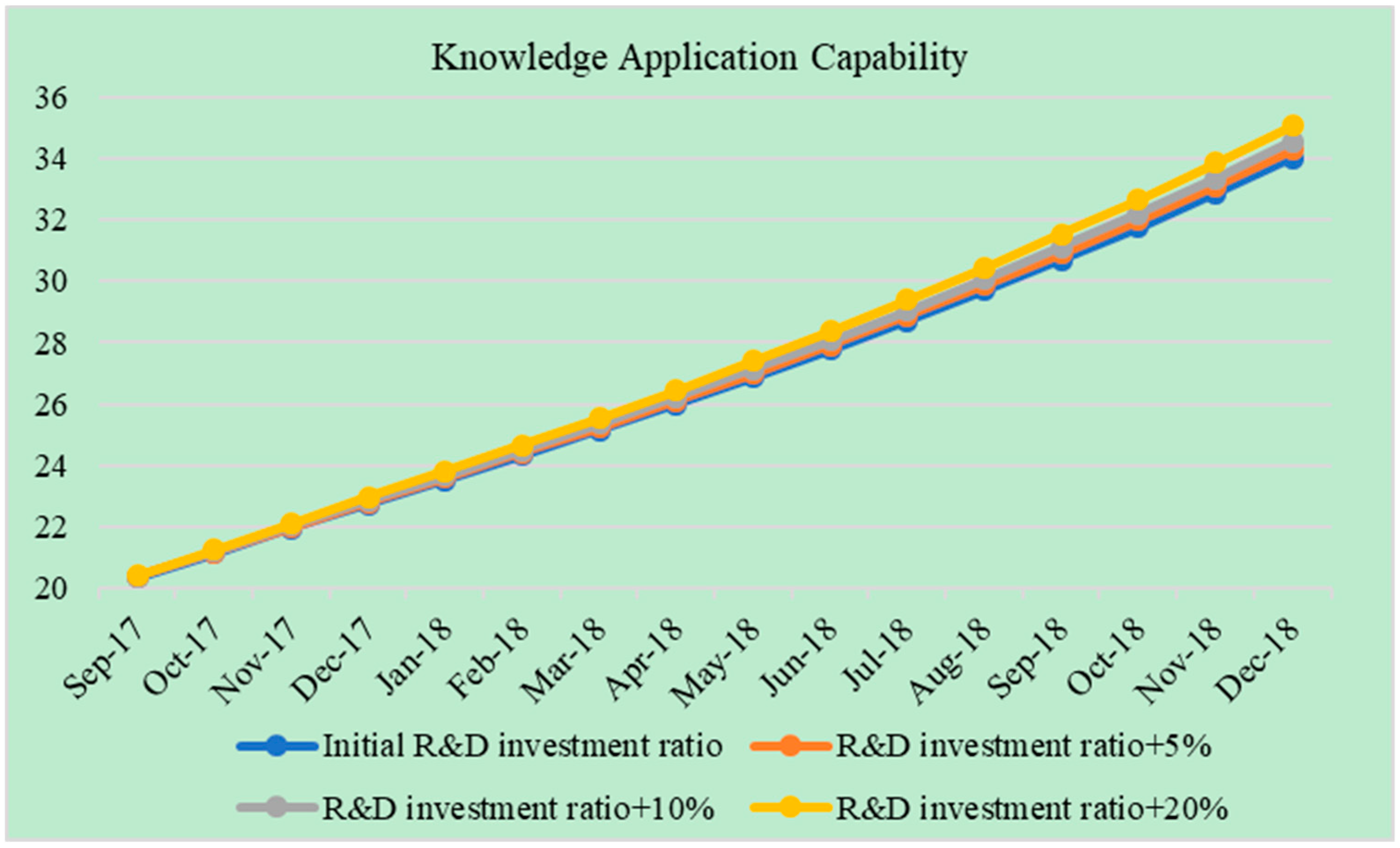
| Item | Measures | Average | Min | Max | Std.Dev |
|---|---|---|---|---|---|
| Patent information | Monthly patent applications | 235 | 146 | 325 | 47 |
| Average wait time | 160 | 48 | 270 | 52 | |
| New Feature Suggestion sub-community | Monthly number of users | 2140 | 1248 | 3126 | 528 |
| Monthly number of posts | 2737 | 1513 | 4266 | 725 | |
| Monthly number of comments | 17,083 | 8040 | 35,050 | 6543 | |
| Monthly number of views | 30,324,058 | 942,642 | 405,535,223 | 104,065,196 | |
| Product Release sub-community | Monthly number of product releases | 28 | 4 | 104 | 26 |
| Items | 2017 | 2016 | 2015 |
|---|---|---|---|
| R&D investment (billion yuan) | 31.51 | 21.04 | 15.12 |
| R&D investment/annual revenue | 2.75% | 3.07% | 2.26% |
| Management expense (billion yuan) | 44 | 29.89 | 22 |
| Management expense/annual revenue | 3.80% | 4.37% | 3.36% |
| Annual revenue (billion yuan) | 1146 | 684 | 668 |
| No | Variable | Type | Equation |
|---|---|---|---|
| 1 | Number of product releases | State | INTEG (Monthly product releases, 874) |
| 2 | Number of patents | INTEG (Monthly net increase in patents, 5173) | |
| 3 | R&D investment | INTEG (Monthly R&D investment, 60) | |
| 4 | Management expense | INTEG (Monthly management expense, 85) | |
| 5 | Technology introduction | Exogenous | WITH LOOKUP(Time) |
| 6 | Interaction activity of viewing | Constant | 14,170 |
| 7 | Interaction activity of commenting | 7.98 | |
| 8 | User innovation behavior activity | 1.28 | |
| 9 | Number of R&D personnel | 5515 | |
| 10 | R&D and management expense ratio | 0.07 | |
| 11 | R&D investment ratio | 0.07 × 3/7 | |
| 12 | FINAL TIME | 16 | |
| 13 | INITIAL TIME | 1 | |
| 14 | TIME STEP | 1 | |
| 15 | Knowledge recognition capability | Auxiliary | Number of R&D personnel × Technology introduction × R&D investment/1×10^5 |
| 16 | Knowledge acquisition capability | 0.75 × Number of R&D personnel × Technology introduction × R&D investment/1×10^5 | |
| 17 | Knowledge transformation capability | 0.45 × Number of R&D personnel × Technology introduction × R&D investment/1×10^5 | |
| 18 | Knowledge application capability | 0.29 × (R&D investment + Management expense) | |
| 19 | Number of users | Number of Patents × 0.25 | |
| 20 | Number of views | Number of users × Interaction activity of viewing | |
| 21 | Number of comments | Number of users* Interaction activity of commenting | |
| 22 | Number of posts | Number of users × User innovation behavior activity | |
| 23 | Quality of creative ideas | (Number of comments + Number of views/1×10^4)/1×10^3 | |
| 24 | Adoption rate of ideas | (Quality of creative ideas × Knowledge recognition ability × Knowledge acquisition ability)/1×10^5 | |
| 25 | Conversion rate of ideas | Knowledge transformation ability/100 | |
| 26 | Monthly revenue | Number of patents × 0.016 | |
| 27 | Management expense ratio | 1- R&D investment ratio | |
| 28 | Monthly product releases | Rate | Adoption rate of ideas × Conversion rate of ideas × Number of posts |
| 29 | Monthly R&D investment and management expense | Monthly revenue × 0.07 | |
| 30 | Monthly R&D investment | Monthly revenue × 0.07 × 3/7 | |
| 31 | Monthly management expense | Monthly revenue × 0.07 × 4/7 | |
| 32 | Monthly net increase in patents | DELAY FIXED (Number of product releases × Knowledge application ability/100, 5) |
| Month | Actual Value | Predicted Value | Difference | Error |
|---|---|---|---|---|
| Feb 2018 | 5412 | 5344.09 | 67.91 | 1.25% |
| Mar 2018 | 5658 | 5526.39 | 131.61 | 2.33% |
| Apr 2018 | 5870 | 5720.46 | 149.54 | 2.55% |
| May 2018 | 6137 | 5926.82 | 210.18 | 3.42% |
| Jun 2018 | 6390 | 6146.03 | 243.97 | 3.82% |
| Jul 2018 | 6536 | 6378.61 | 157.39 | 2.41% |
| Aug 2018 | 6788 | 6625.05 | 162.95 | 2.40% |
| Sep 2018 | 6992 | 6886.54 | 105.46 | 1.51% |
| Oct 2018 | 7167 | 7164.40 | 2.60 | 0.04% |
| Nov 2018 | 7501 | 7460.06 | 40.94 | 0.55% |
| Dec 2018 | 7753 | 7774.76 | −21.76 | −0.28% |
| Month | Actual Value | Predicted Value | Difference | Error |
|---|---|---|---|---|
| Sep 2017 | 921 | 895.09 | 25.91 | 2.81% |
| Oct 2017 | 944 | 917.17 | 26.83 | 2.84% |
| Nov 2017 | 953 | 940.12 | 12.88 | 1.35% |
| Dec 2017 | 963 | 963.84 | −0.84 | −0.09% |
| Jan 2018 | 979 | 988.18 | −9.18 | −0.94% |
| Feb 2018 | 986 | 1013.02 | −27.02 | −2.74% |
| Mar 2018 | 992 | 1039.91 | −47.91 | −4.83% |
| Apr 2018 | 1000 | 1069.00 | −69 | −6.90% |
| May 2018 | 1004 | 1100.44 | −96.44 | −9.61% |
| Jun 2018 | 1053 | 1133.02 | −80.02 | −7.60% |
| Jul 2018 | 1094 | 1166.63 | −72.63 | -6.64% |
| Aug 2018 | 1129 | 1201.12 | −72.12 | −6.39% |
| Sep 2018 | 1168 | 1236.31 | −68.31 | −5.85% |
| Oct 2018 | 1272 | 1271.96 | 0.04 | 0.00% |
© 2019 by the authors. Licensee MDPI, Basel, Switzerland. This article is an open access article distributed under the terms and conditions of the Creative Commons Attribution (CC BY) license (http://creativecommons.org/licenses/by/4.0/).
Share and Cite
Wu, B.; Gong, C. Impact of Open Innovation Communities on Enterprise Innovation Performance: A System Dynamics Perspective. Sustainability 2019, 11, 4794. https://doi.org/10.3390/su11174794
Wu B, Gong C. Impact of Open Innovation Communities on Enterprise Innovation Performance: A System Dynamics Perspective. Sustainability. 2019; 11(17):4794. https://doi.org/10.3390/su11174794
Chicago/Turabian StyleWu, Bing, and Chunyu Gong. 2019. "Impact of Open Innovation Communities on Enterprise Innovation Performance: A System Dynamics Perspective" Sustainability 11, no. 17: 4794. https://doi.org/10.3390/su11174794
APA StyleWu, B., & Gong, C. (2019). Impact of Open Innovation Communities on Enterprise Innovation Performance: A System Dynamics Perspective. Sustainability, 11(17), 4794. https://doi.org/10.3390/su11174794





